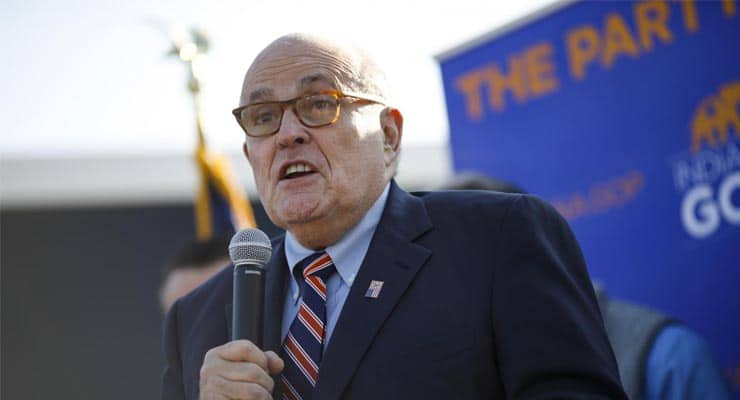Did Twitter allow people to “invade” Rudy Giuliani’s tweets? Fact Check
A claim made by politician Rudy Giuliani asserts that social media micro-blogging platform Twitter allowed someone to “invade” his “text” with an anti-trump message.
Given the context, we are assuming that “text” actually refers to a tweet he had made on November 30th 2018.
We rate the claim false, though it appears to be an ignorance as to how the Internet operates as opposed to an intentional fabrication.

Twitter allowed someone to invade my text with a disgusting anti-President message. The same thing-period no space-occurred later and it didn’t happen. Don’t tell me they are not committed cardcarrying anti-Trumpers. Time Magazine also may fit that description. FAIRNESS PLEASE
In the first tweet above, Giuliani inadvertently missed a space after the period symbol; by doing so, he automatically created a web URL that Twitter – as they always do when they detect a URL – automatically hyperlinked (turned it blue and clickable.)
A valid URL is detected when text is followed by the period which is followed by a valid top level domain (TLD), all with no spaces. The web address that Giuliani created was G-20.In. That’s the text G-20, followed by the period, followed by In, the TLD for India.
Twitter recognised the URL (even though, at the time, it didn’t lead to a live website) and made it both blue and clickable, which is perfectly normal. (Incidentally, the text would have turned blue as Giuliani was writing the tweet, and not after he tweeted it.)
Once posted, someone noticed Giuliani’s mistake, and decided to purchase and publish a simple webpage at the URL Giuliani inadvertently tweeted. That website carried a simple and direct anti-Trump message.
As such, the claim made by Giuliani that someone had “invaded” his “text” and that Twitter had “allowed it” is completely nonsensical. Twitter automatically hyperlinks all detectable URL addresses as soon as they are typed in, which is exactly what happened here, and Twitter obviously has no control over the websites that those links lead to.
Sponsored Content. Continued below...
Giuliani also claimed that he has missed a space after a period before and Twitter had not hyperlinked the text; however this claim is also founded in online inexperience. Twitter only hyperlinks text if it is a valid URL address, meaning it has to find a valid TLD after the period. In the case above, he coincidentally used the word ‘In’, which happens to the TLD for India. In previous cases where Twitter didn’t hyperlink Giuliani’s text, it is likely that the word after the period was not a valid TLD, and consequently would not have been a valid URL and not hyperlinked by Twitter.
Ultimately, the claim that Twitter had somehow allowed the “invasion” (though not really an invasion at all) is nonsense; nothing extraordinary occurred, and claims of a conspiracy are merely the result of a fundamental ignorance as to how the Internet works.
That’s a tad worrying when you consider that in 2017 Giuliani was once appointed as an informal cyber-security advisor to the president. Let’s just hope that position was very informal indeed.

Continued below...
Thanks for reading, we hope this article helped, but before you leave us for greener pastures, please help us out.
We're hoping to be totally ad-free by 2025 - after all, no one likes online adverts, and all they do is get in the way and slow everything down. But of course we still have fees and costs to pay, so please, please consider becoming a Facebook supporter! It costs only 0.99p (~$1.30) a month (you can stop at any time) and ensures we can still keep posting Cybersecurity themed content to help keep our communities safe and scam-free. You can subscribe here
Remember, we're active on social media - so follow us on Facebook, Bluesky, Instagram and X
